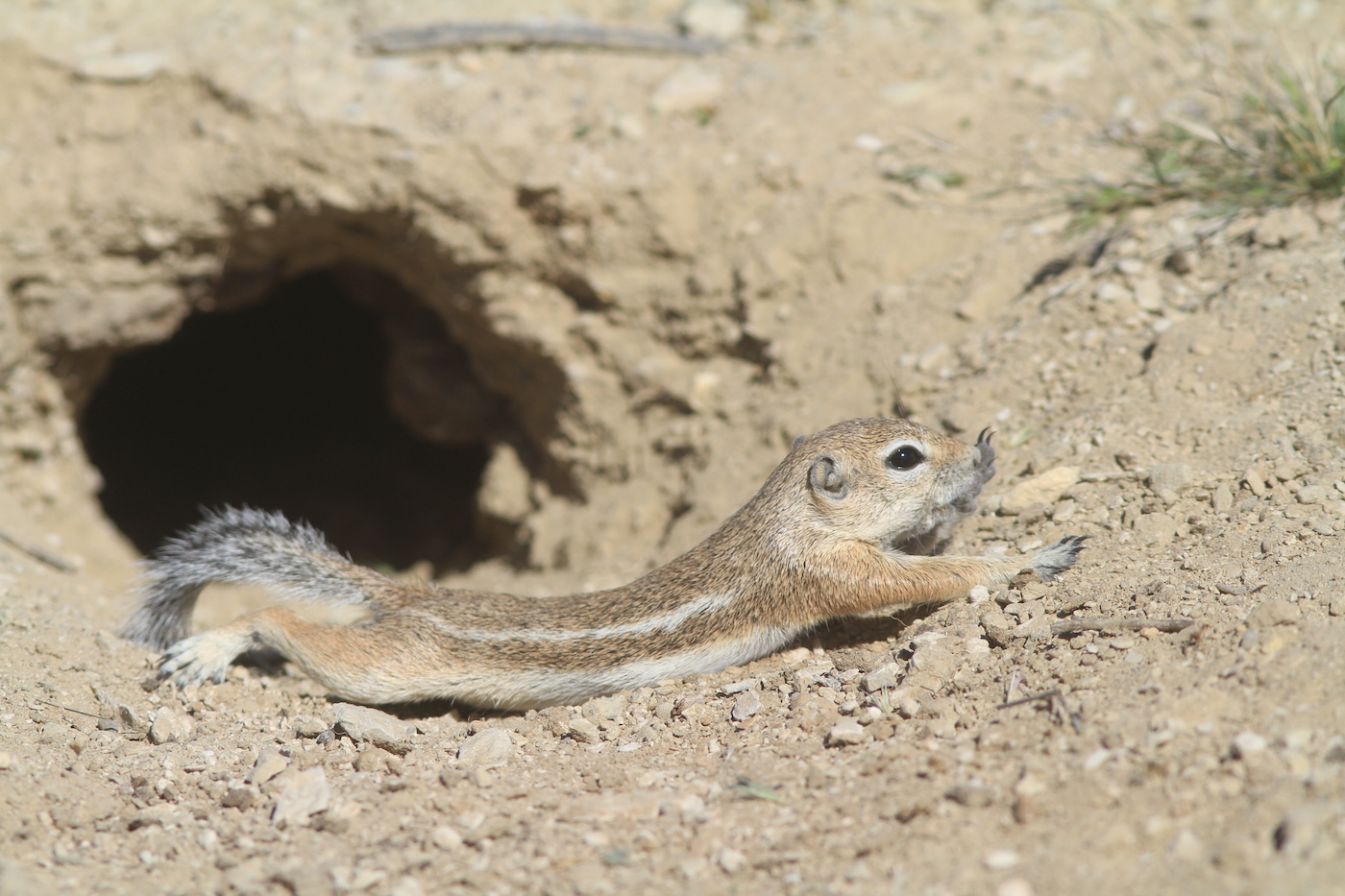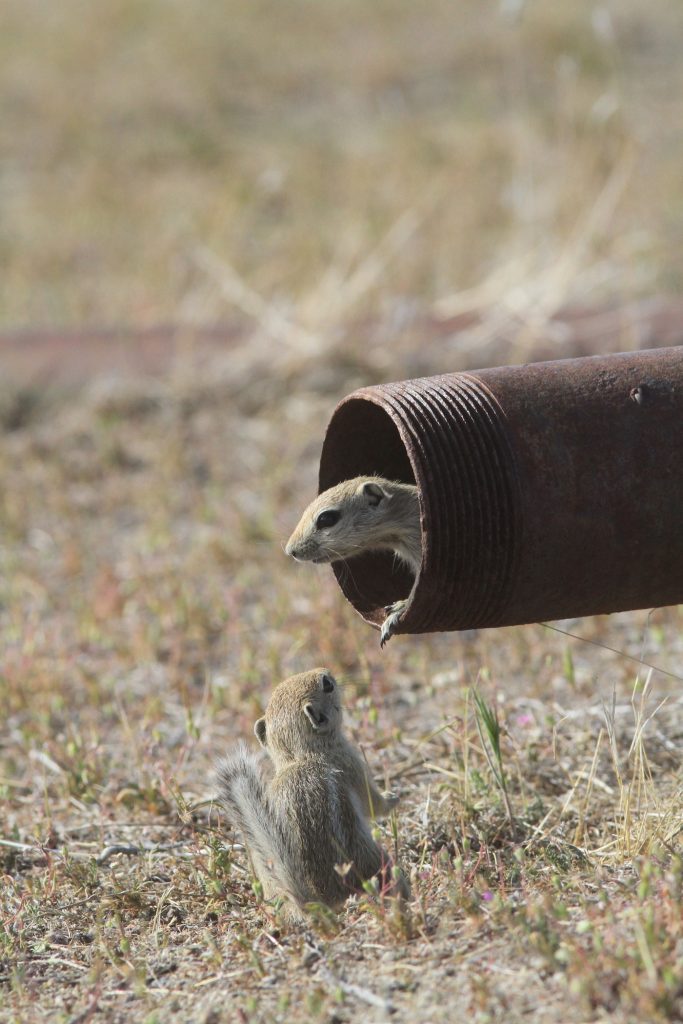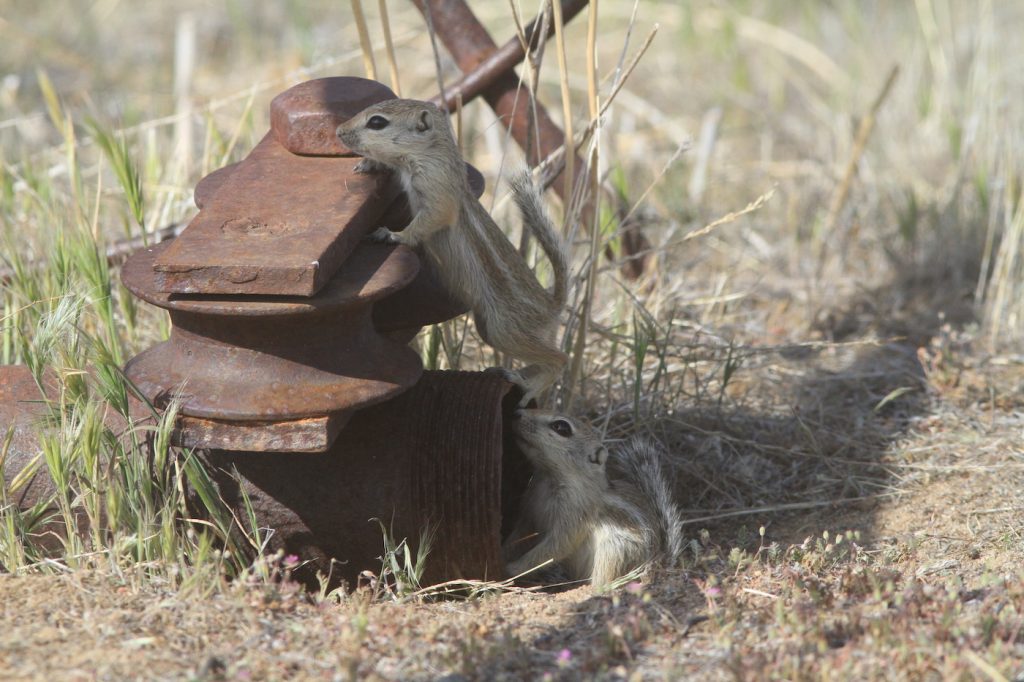Little Hooligans of the Veld

She convulsed mightily standing watch on the fringe of her burrows. Her black milk ducts protruded through buff, tan fur as her belly full of rich milk warbled while she belted out a series of quavering trills warning her kits of potential danger.
The watchful San Joaquin antelope ground squirrel (Ammospermophilus nelsoni) guarded her territory with utter aplomb. Standing eight inches tall, she feasted on new green growth as spring hovered across California’s San Joaquin Valley.
She also kept a keen, attentive eye on all six of her tiny, frenetic kits who were busy feeding, but between nibbles they also rough housed through and around their complex, series of burrows, the entry and exit points ideal for seemingly infinite games of chase.
However, once a red-tailed hawk soared overhead, the mood surrounding the burrows quickly shifted. The presence of the majestic raptor casted shadows over the antelope ground squirrel burrows, sending all the rambunctious kits scurrying underground in the high desert veld.
Time is Fleeting

Their pace was feverish, cheeks nearly bursting of blades of brome grasses. Then, running back to their maze of burrows they stashed their precious morsels. Their actions appeared as if they were performing a daily chore, and they were. After all, the average lifespan of San Joaquin antelope ground squirrels is only one year, so they’re busy squirrels as if every moment counts, except in times of extreme heat where they choose to lay low underground.
Their habitat throughout the San Joaquin Valley has greatly diminished over the last couple centuries, mostly due to agriculture. In California they are listed as a species of special concern, but on the IUCN Red List they are listed as endangered due to habitat loss. Pockets of habitat remain though, and California Fish and Wildlife (CDFW) environmental scientist Craig Fiehler is in the process of translocating antelope ground squirrels back to their old stomping grounds attempting to reestablish historic habitat.
“I have wanted to study San Joaquin antelope squirrels for some time,” said Fiehler, who has worked for CDFW since 2006. “I had been thinking about testing translocation strategies for antelope ground squirrels.”
In 2011-12 the CDFW accepted the 12,000 acres of mitigation land that was secured as part of the Topaz solar farm project. Fiehler was placed in charge of managing those lands north of the Carrizo Plain National Monument. These lands were finally designated as the North Carrizo Ecological Reserve (NCER) in 2020. Most of those lands had been in dryland farming and cattle grazing, some right up until the lands transferred to CDFW. This was a similar situation with the lands that eventually made up the Carrizo Plain National Monument.
Initially, Fiehler and his team collared three groups of 20 squirrels. One group was collared and remained in the National Monument as a “control” group, and they were not moved. One group was collared and moved up to the NCER into an area with no giant kangaroo rats (GKR). The last group was collared and moved to a neighboring parcel that is under conservation and managed by Sequoia Riverlands Trust. This area had GKR present. Fiehler was interested in determining in what way underground habitat (GKR burrows in this case) affected translocation success. It was learned that having an abundance of excess burrows in the translocation area would benefit newly translocated antelope squirrels.
“In general, it seems like the squirrels like to expand to adopt burrows that have been already dug by GKR or even Heermann’s kangaroo rat (HKR),” Fiehler said.
“These burrows serve as a refuge for the squirrels during daytime activities and at night as well when they are sleeping.”
Currently, this study is still occurring in the Carrizo Plain and the surrounding regions to the north. Until the study is finished, squirrels will not be moved throughout the San Joaquin Valley. It is hoped that the results of this study will inform future conservation efforts for antelope squirrels in the Valley.
“However, as some lands go into retirement from agriculture,” said Fiehler, “there is some hope in connecting these islands and perhaps connecting larger squirrel populations together.”
Of Grasslands, Burrows, and Ranchland Relics
For over 150 years ranching took place on California’s historic grasslands. Old ranchlands in the San Joaquin Valley that have come and gone are then sometimes reclaimed by wildlife. A perfect example of this is the Carrizo Plain National Monument, a 250,000-acre grassland haven that possesses more endangered species than anywhere else in California.
Historically, the San Joaquin antelope squirrel ranged from northwestern Merced and eastern San Benito counties south to the northern border of Santa Barbara County, skirting the edges of the Los Padres National Forest and the Cuyama Valley. Prior to cultivation, the area within which this species was distributed was approximately 3.5 million acres. In 1979, an estimated 680,000 acres of uncultivated habitat remained and only about 101,962 acres was of fair to good quality.
“In general, I am impressed with just how tough these animals are,” said Fiehler. “They are physiologically adapted to a desert environment and it’s fascinating to me that they can persist with no water to drink for months at a time. They can be active during the heat of the day and use their little tail as a parasol when there is not shade available. I also find it interesting that they live in loose colonies and look out for each other.”

Current populations include elevations of 50 meters (165 feet) on the floor of the San Joaquin Valley to around 1,100 meters (3,609 feet) in the Temblor Mountains. In 1979, substantial populations were located within the areas around Lokern and Elk Hills in western Kern County and on the Carrizo and Elkhorn Plains in eastern San Luis Obispo County. Since 1979, San Joaquin antelope squirrels have disappeared from many of the smaller habitat clusters on the Valley floor.
However, the Carrizo Plain offers a look into what the entire San Joaquin Valley once appeared as and observing wildlife like the antelope ground squirrel reveals just one of many inner workings of a grassland habitat. Once their burrows are established and parental bonds are confirmed, the best entertainment begins when the kits (or pups) arrive. An average family size consists of six to nine kits. After 30 days those kits are on their own, weaned from their mother and are off foraging around their burrows.
Some moms are more tolerant than others and will accept the presence of a low-lying photographer. Scooching along on elbows and toes is well worth experiencing the ongoing antics of the tiny kits. Mothers are known as “does” and dads are known as “bucks” and like a diligent sentry, stand watch while the kits frolic. They are multi-taskers eating while standing watch.
Especially eventful is observing their antics in and around old ranching implements such as piping, rakes, trailer hitches and the like. The more kits around the more entertaining the antics become, and the rusty relics transform into grassland jungle gyms. Beyond chasing each other adults and kits alike perform series of planks and stretches while reveling in furious dust baths.
However, once either parent lets out a warning trill, the parents and kits will scamper for cover if a threat is in the area. They also respond to the warning calls of white-crowned sparrows and horned larks, both of which are abundant in the Carrizo Plain and can be seen around antelope ground squirrels. Once a potential threat subsides, the kits can’t help themselves, their curiosity forcing them to venture outside their burrows once again.
“It would not surprise me that they would use the alarm calls of co-occurring species as an early warning system,” said Fiehler. “Horned larks are especially common on our study sites. Since our sites lack a shrub component, the white-crowned sparrows are not present in any appreciable numbers.”
With so much habitat fragmentation in the San Joaquin Valley, I asked Fiehler if he felt it was only a matter of time before the San Joaquin antelope ground squirrel goes the way of the dodo. He answered my question by referring to a study he did back in 2008 on an oilfield in the San Joaquin Valley.
“At that time, we found that antelope squirrels were able to persist up to moderate habitat disturbance levels,” he said. “This leads me to believe that they may not have as narrow habitat requirements as some of the other rare species in the valley. If this is the case, I don’t fear for their survival as long as there are enough pockets of habitat and more of a focus of connecting newly acquired conservation lands to the other pockets of existing habitat.
“The results of our current study may help in developing strategies in which areas of the valley could potentially be repopulated with antelope squirrels. This could end up in an increase in the antelope squirrel population which would be great to see.”





